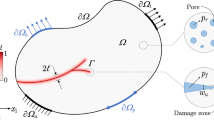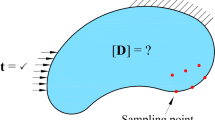We propose an approach to the description of thermoelastic processes in deformable solids with regard for the structural heterogeneity of the material and the geometric heterogeneity of the surface of the body. In formulating the source relations, we use the methods of thermodynamics of nonequilibrium processes and nonlinear continuum mechanics. We take into account the structure of the material by introducing an irreversible component of the vector of mass flow. The geometric subsurface heterogeneity of the body is taken into account by introducing mass sources modeling its properties and by the dependence of the characteristics of materials, including the moduli of elasticity, on density. We study the equilibrium state of the half space. It is shown that two characteristic sizes correspond to the distributions of stresses and density. One of these sizes is connected with the structural heterogeneity of the material and the other is connected with the geometric heterogeneity of the actual surface of the body. We discuss the limits of applicability of the local gradient approach in the case of linearized approximation.
Similar content being viewed by others
References
Ya. I. Burak, and T. S. Nagirnyi, “Mathematical modeling of local gradient processes in inertial thermomechanical systems,” Prikl. Mekh., 28, No. 12, 3–23 (1992); English translation: Int. Appl. Mech., 28, No. 12, 775–793 (1992).
Ya. Burak, E. Chaplya, T. Nahirnyi, V. Chekurin, V. Kondrat, O. Chernukha, H. Moroz, and K. Chervinka, Physicomathematical Modeling of Complex Systems [in Ukrainian], SPOLOM, Lviv (2004).
P. Glansdorff and I. Prigogine, Thermodynamic Theory of Structure, Stability and Fluctuations, Wiley, London (1971).
A. N. Guz and J. J. Rushchitsky, “Establishing foundations of the mechanics of nanocomposites (Review),” Prikl. Mekh., 47, No. 1, 4–61 (2011); English translation: Int. Appl. Mech., 47, No. 1, 2–44 (2011).
T. S. Nahirnyi and K. A, Chervinka, Thermodynamic Models and Methods of Thermomechanics with Regard for the Subsurface and Structural Heterogeneities. Fundamentals of Nanomechanics I [in Ukrainian], SPOLOM, Lviv (2012).
T. S. Nahirnyj, K. A. Chervinka, and Z. V. Boiko, “On the choice of boundary conditions in problems of the local gradient approach in thermomechanics,” Mat. Met. Fiz.-Mekh. Polya, 54, No. 3, 199–206 (2011); English translation: J. Math. Sci., 186, No. 1, 130–138 (2012).
W. Nowacki, Teoria Sprężystości, PWN, Warszawa (1970).
G. G. Adams, “Adhesion at the wavy contact interface between two elastic bodies,” Trans. ASME. J. Appl. Mech., 71, No. 6, 851–856 (2004).
H. Askes and E. C. Aifantis, “Gradient elasticity in statics and dynamics: An overview of formulations, length scale identification procedures, finite element implementations and new results,” Int. J. Solids Struct., 48, No. 13, 1962–1990 (2011).
H. Askes and I. M. Gitman, “Review and critique of the stress gradient elasticity theories of Eringen and Aifantis,” in: G. A. Maugin and A. V. Metrikine (editors), Mechanics of Generalized Continua: One Hundred Years After the Cosserats, Chapter 21, Ser. Advances in Mechanics and Mathematics, Vol. 21, Springer, New York (2010), pp. 203–210.
E. C. Aifantis, “Exploring the applicability of gradient elasticity to certain micro/nano reliability problems,” Microsyst. Technol., 15, No. 1, 109–115 (2009).
V. A. Buryachenko, “On thermoelastostatics of composites with nonlocal properties of constituents. I. General representations for effective material and field parameters,” Int. J. Solids Struct., 48, No. 13, 1818–1828 (2011).
Z. P. Bažant, Scaling of Structural Strength, Elsevier, London (2005).
Z. P. Bažant and M. Jirásek, “Nonlocal integral formulations of plasticity and damage: Survey of progress,” J. Eng. Mech.-ASCE, 128, No. 11, 1119–1149 (2002).
M. G. D. Geers, V. G. Kouznetsova, and W. A. M. Brekelmans, “Multi-scale computational homogenization: Trends and challenges,” J. Comput. Appl. Math., 234, No. 7, 2175–2182 (2010).
N. M. Ghoniem, E. P. Busso, N. Kioussis, and H. Huang, “Multiscale modeling of nanomechanics and micromechanics: An overview,” Phil. Mag., 83, Nos. 31-34, 3475–3528 (2003).
J.-G. Guo and Y.-P. Zhao, “The size-dependent elastic properties of nanofilms with surface effects,” J. Appl. Phys., 98, No. 7, 074306–11 (2005).
T. Nahirnyj and K. Tchervinka, “Interface phenomena and interaction energy at the surface of electroconductive solids,” Comput. Meth. Sci. Technol., 14, No. 2, 105–110 (2008).
G. A. Maugin, “Nonlocal theories or gradient-type theories: A matter of convenience?” Arch. Mech., 31, No. 1, 15–26 (1979).
M. D. Paola, G. Failla, and M. Zingales, “The mechanically-based approach to 3D nonlocal linear elasticity theory: Long-range central interactions,” Int. J. Solids Struct., 47, Nos. 18-19, 2347–2358 (2010).
C. Polizzotto, “Unified thermodynamic framework for nonlocal/gradient continuum theories,” Eur. J. Mech. A-Solid, 22, No. 5, 651–668 (2003).
C. Polizzotto, P. Fuschi, and A. A. Pisano, “A strain-difference-based nonlocal elasticity model,” Int. J. Solids Struct., 41, Nos. 9-10, 2383–2401 (2004).
C. Sansour and S. Skatulla, “A strain gradient generalized continuum approach for modeling elastic scale effects,” Comput. Meth. Appl. Mech. Eng., 198, Nos. 15-16. 1401–1412 (2009).
S. Schmauder and L Mishnaevsky Jr., Micromechanics and Nanosimulation of Metals and Composites: Advanced Methods and Theoretical Concepts, Springer, Berlin–Heidelberg (2009).
R. M. Shvets, R. M. Martynyak, and A. A. Kryshtafovych, “Discontinuous contact of an anisotropic half plane and a rigid base with disturbed surface,” Int. J. Eng. Sci., 34, No. 2, 183–200 (1996).
C. P. Ursenbach, “Simulation of elastic moduli for porous materials,” CREWES Res. Rep., 13, 83–98 (2001).
Y. M. Wang and E. Ma, “Mechanical properties of bulk nanostructured metals,” in: M. J. Zehetbauer and Y. T. Zhu (editors), Bulk Nanostructured Materials, Chapter 19, Wiley–VCH, Weinheim (2009), pp. 425–453.
A. Zaoui, “Continuum micromechanics: Survey,” J. Eng. Mech.-ASCE, 128, No. 8, 808–816 (2002).
Author information
Authors and Affiliations
Additional information
Translated from Matematychni Metody ta Fizyko-Mekhanichni Polya, Vol. 57, No. 4, pp. 84–94, October–December, 2014.
Rights and permissions
About this article
Cite this article
Nahirnyi, T.S., Chervinka, K.A. Mass Sources and Modeling of Subsurface Heterogeneities in Deformable Solids. J Math Sci 220, 103–115 (2017). https://doi.org/10.1007/s10958-016-3170-x
Received:
Published:
Issue Date:
DOI: https://doi.org/10.1007/s10958-016-3170-x




